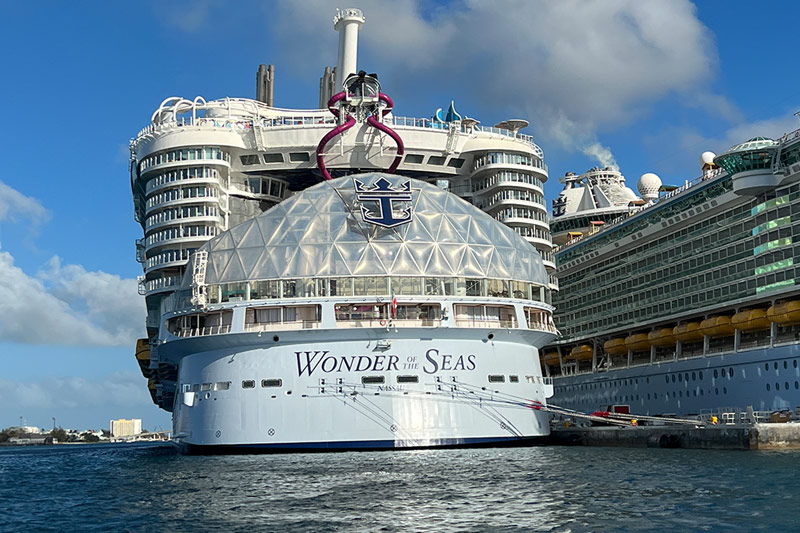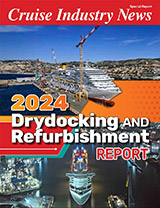Royal Caribbean Group today reported first quarter 2022 operating loss of $(1.2) billion and loss per share of $(4.58).
The group said it continues to make strides in its healthy return to operations in a strong demand environment.
According to a press release, load factors continue to improve sequentially with total revenue per Passenger Cruise Day up versus record 2019 levels.
Operating cash flow significantly improved throughout the first quarter and approached breakeven in March.
“It is gratifying to see our ships and crew returning to our mission of delivering the best vacation experiences in a safe and responsible way,” said Jason Liberty, president and chief executive officer of the Royal Caribbean Group. “Despite the impact of Omicron earlier in the year and the horrific conflict in Ukraine, we are encouraged by the strong demand for cruising and the steady acceleration in booking volumes,” Liberty added. “Since the beginning of March, booking volumes have exceeded the record levels achieved in 2019 and we are optimistic that 2022 will be a strong transitional year as we return to full operations and profitability in the second half of the year.”
Business Highlights
- By the end of the first quarter of 2022, the Group had returned 54 out of 62 ships to operations across its five brands, representing close to 90% of worldwide fleet capacity.
- During the first quarter, the Group carried approximately 800,000 guests and achieved record guest satisfaction scores and record total revenue per Passenger Cruise Day.
- The Group continues to make progress towards profitability with operating cash flow only slightly negative in March and turning positive in April.
- The Group expects to return the full fleet to operations before the summer season of 2022.
- Across all markets, bookings in the first quarter of 2022 were higher than in the fourth quarter of 2021, and throughout the first quarter, bookings improved each week.
- In March and April, booking volumes have been significantly higher than the same period in 2019.
- The second half of the year is booked slightly below historical ranges but at higher prices than 2019, with and without future cruise credits (FCCs). Based on the strong and close-in nature of bookings, the company expects load factors will continue to improve each quarter and expects fleetwide load factors to exceed 100% by year end.
- For 2023, all quarters are currently booked within historical ranges at record pricing.
- The Group is managing through inflationary and supply chain challenges, mainly related to fuel and food costs, as well as transitory costs related to health and safety protocols, which are expected to weigh on 2022 earnings.
- The Group expects a return to net profit for the second half of 2022.
First Quarter 2022
The company reported Net Loss for the first quarter of 2022 of $(1.2) billion or $(4.58) per share compared to Net Loss of $(1.1) billion or $(4.66) per share in the prior year. The company also reported Adjusted Net Loss of $(1.2) billion or $(4.57) per share for the first quarter of 2022 compared to Adjusted Net Loss of $(1.1) billion or $(4.44) per share in the prior year. The Net Loss and Adjusted Net Loss for the quarter are primarily the result of the continued impact of the COVID-19 pandemic on the business.
The Group made significant progress in its recovery trajectory in the first quarter mainly due to continued strong demand for cruising and nimble execution in a challenging operating environment. During the first quarter, four additional ships resumed operations. The company continues to thoughtfully ramp up the fleet and load factors while emphasizing industry-leading health and safety standards, world-class guest experiences and financial prudence.
Ships that operated the Group’s core?itineraries in the first quarter achieved a load factor of 59%. Core itineraries exclude sailings during the early ramp-up period of up to four weeks.? First quarter load factor was 57% with month-over-month sequential improvements. March load factors were 68%. Total revenue per Passenger Cruise Day in the first quarter was up 4% versus record 2019 levels driven by continued strong onboard revenue performance. Cash flow from ships in operation was positive in the first quarter. The Groups’ cruise operating expenses per Available Passenger Cruise Days (APCD) improved in the first quarter 2022 from the fourth quarter 2021 despite inflationary pressures and elevated health protocol costs.
Continued Fleet Ramp-Up
The Group’s fleet size expanded to 63 with the delivery of Wonder of the Seas and Celebrity Beyond in the first quarter and early second quarter, respectively. These ships, along with six other new ships which have joined the fleet over the last 20 months and represent over 10% of total capacity, are significantly contributing to yield growth and profitability. The Group expects its entire fleet of 63 ships will be operational by the beginning of the 2022 summer season.
The Group is now offering cruises in almost all of its destinations. Australia, one of the last remaining countries to re-open, announced the resumption of cruising effective April 2022. The Group expects to return to Australia for the local summer season in the fourth quarter of 2022. China remains closed to cruising due to the ongoing lockdowns. While the Group remains optimistic to capture long-term growth opportunities in that market, ships planned for China have been temporarily redeployed to other markets.
The Group expects to operate approximately 10.3 million Available Passenger Cruise Days (APCD) for the second quarter with load factors of 75% to 80%. The Group also expects cash flow from ships in operation to be positive in the second quarter. Operating cash flow significantly improved throughout the first quarter and is turning positive in April.
Update on Bookings
Booking volumes in the first quarter improved consistently week-over-week and reached typical Wave levels at the end of the quarter. Bookings have now been surpassing comparable 2019 levels for the last two months with particularly strong trends for North America based itineraries. In addition, the elevated cancellations experienced earlier in the year returned to pre-Omicron levels as cases subsided in February. While load factors for sailings in the second half of 2022 are currently slightly below historical levels, consumers are booking their cruises closer to sailing and the Group is capitalizing on that healthy close-in demand to improve load factors. For the full year and the second half of 2022, pricing remains higher than in 2019 both including and excluding FCCs.
Bookings for Europe sailings improved throughout the first quarter but softened due to the war in Ukraine with a bigger impact on Baltic itineraries. While bookings for Europe are now exceeding 2019 levels for the same period, the situation in Ukraine is expected to weigh on load factors in Europe this summer.
“The performance of our core business continues to strengthen, fueled by strong demand and excellent operational execution,” said Naftali Holtz, chief financial officer at Royal Caribbean Group. “Our near-term focus is to return to full operations and profitability as we execute on our recovery and build for long term success.”
As of March 31, 2022, the company’s customer deposit balance was $3.6 billion. This represents an improvement of about $400 million over the previous quarter despite the significant quarter-over-quarter increase in revenue recognition and near-term cancellations due to the Omicron variant, both of which reduced the customer deposit balance. The customer deposit balance at the end of the first quarter of 2022 was similar to the March 31, 2019 balance for the three brands. Approximately 27% of the customer deposit balance is related to FCCs compared to 32% in the prior quarter, a positive trend indicating new demand. To date, approximately 56% of FCCs have been redeemed.
Liquidity and Financing Arrangements
As of March 31, 2022, the company’s liquidity position was $3.8 billion, which includes cash and cash equivalents, undrawn revolving credit facility capacity, and a $700 million commitment for a 364-day term loan facility.
In January, the company completed an issuance of $1 billion of 5.375% senior unsecured notes. These notes are due in 2027 with proceeds to be used to repay principal payments on debt maturing in 2022. In February, the company entered into a $3.15 billion backstop facility, which provides flexibility in refinancing debt maturities due in June 2023.
Net interest expense for the second quarter of 2022 is expected to be in the range of $300-$310 million.
Fuel Expense
Bunker pricing, net of hedging, for the first quarter was $588 per metric ton and consumption was 321,000 metric tons.
Consumption is 55% hedged via swaps for the remainder of 2022 and 25% hedged for 2023. For the remainder of 2022 and all 2023, the annual average cost per metric ton of the fuel swap portfolio is approximately $483 and $585, respectively.
Based on current fuel prices, the company expects approximately $271 million of fuel expense in its second quarter 2022 at an average pricing of $695 per metric ton net of hedging.
Capital Expenditures
The expected capital expenditures for 2022 are $3.0 billion. These expenditures are mainly driven by new shipbuilding projects that have committed financing.
Depreciation and amortization expenses for the second quarter of 2022 are expected to be in the range of $350-$355 million.




